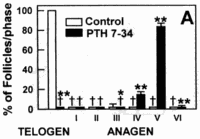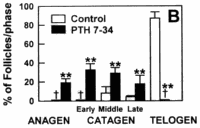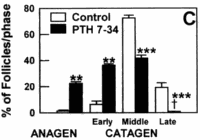 |
 |
 |
Figure 4. Histomorphometric analysis of the hair follicles from the back skin of control and PTH (7-34)-treated mice on the day of maximal macroscopic effects. (A) On the 14th day of treatment oftelogen mice, both the control and treated groups had 13 and 14 mice, respectively. (B) On the 9th day of treatment of spontaneous anagen mice, both the control and treated groups had 14 mice each. (C) On the 11th day of treatment of depilarion-induced anagen mice, the control and treated groups contained 15 mice each. t, values less than 1%; ***, p < 0.001; **. p < 0.01; *, p < 0.05.
if the hair follicle keratinocyte continues to produce PTHrP during its proliferative phase, it, in turn, could exert its antimitotic activity on the dermal papilla, thereby terminating further hair growth and initiating the follicle into catagen and telogen. This effect would render PTHrP an ideal candidate for being one of the long elusive cutaneous chalones (Chase, 1954; Paus et al, 1990, 1991, 1994b, 1994c).
There is additional evidence that PTHrP can alter the hair cycle. Transgenic mice that overexpressed PTHrP displayed a profound disturbance in hair follicle development, particularly in abdominal skin, where a complete lack of hair follicle formation was observed (Wysolmerski et al, 1994). It was also found that whereas the PTHrP agonist PTHrP (1-34) inhibited epidermal proliferation and had no effect on the number or length of hairs of SKH-1 mice, PTH (7-34) had a profound effect on enhancing epidermal proliferation and increasing the number and length of hair shafts (Holick et al, 1994). Because the SKH-1 hairless mouse is not a good model for hair research, however, it is difficult to compare those results with our observations in C57 BL/6 mice. Although it may be possible that PTH (7-34) had a direct effect on melanogenesis, there is no evidence fromin vivo studies to suggest that PTHrP or PTH (7-34) alter melanogenesis (Holick et al, 1994; Wysolmerski et al, 1994). On the background of these data, our observations strongly suggest that PTHrP is a powerful hair cycle modulator involved in anagen termination and telogen maintenance that functions as a molecular brake on anagen.
Our observations demonstrating the dramatic effect of PTH (7—34) on the hair cycle offers a new opportunity to develop PTH analogs for treating disorders of hair growth. Although the PTH (7-34) may have a relatively short circulating half-life (Kukreja et al, 1994), it appears that once it reaches the hair follicle, its biologic half-life is prolonged, resulting in a profound effect on the hair cycle.
We would like to thank David Jackson for his excellent artwork. This work was supported in part by National Institutes of Health Grants DK 43690 and CA 71119-01 (MFH); Endocrine Training Grant DK 07201 (EO); and Deutsche Krebshilfe Wl/94/Pa 1 (RP).
REFERENCES
- Adilasoy EJ, Bums WJ, and Milstone LM: Immimohistochemical localization of parathyroid hormone-related protein (PTHrP) in normal human skin. J Invest Dennatcl 96:277-280,1991
- Broadus AE, Mangin M, Ikeda K, Insogna KL, Weir EC, Burns WJ, Stewart AF: Humoral hypercalcemia ofcancer: identification of a novel parathyroid homone-likepeptide. IV EnglJMed 319:556-563, 1988
- Chase HB: Growth of the hair. Physial Rev 34:113-126. 1954
- Hanafin NM, Chen TC, Heinrich G, Segre GV, and Holick MF: Cultured human fibroblasts and not cultured human kerarinocytes express a PTH/PTHrP receptor mRNA.J Invest Dematol 105:133-137, 1995
- HaymanJA, DanksJA, Ebeling PR, MosleyJM, Kemp BE, Martin TJ: Expression of parathyroid hormone related protein in normal skin and in tumours of skin and skin appendages.JJWi^ 158:293-296,1989
- HebertJM, Tosenquist T, Gotz J, Martin R: FGF5 as a regulator of the hair growth cycle: Evidence from targeted and spontaneous mutations. Cell 78:1017-1025, 1994
- Henderson JE, Kremer R, Rhim JS, Goltzman D: identification and functional characterization of adenylate cyclase-linked receptors for parathyroid hormonelike peprides on immortalized human keratinocytes. Endocrinology 130:449—457, 1992
- Holick MF, Ray S, Chen TC, Tian X, and Persons KS: Novel functions of a parathyroid hormone antagonist: stimulation of epidermal proliferation and hair growth in mice. Proc Nati Acad Sci USA 91:8014-8016, 1994
- Juppner H, Abou-Samra AB, Freeman M, Kong XF, Schipani E, Richards J, et al: A G protein-linked receptor for parathyroid hormone and parathyroid hormone-related peptide. Science 254:1024-1026,1991
- Kaiser SM, Laneuville P, Bemier SM, RhimJS, Kremer R, and Goltzman D: Enhanced growth of a human keratinocyte cell line induced by antisense RNA for parathyroid hormone-related peptide.J Biol Chem 267:13623-13628, 1992
- Kukreja SC, D’Anza JJ, Wimbiscus SA, Fisher JE, McKee RL, Caulfield MP, et at: Inactivation by plasma may be responsible for lack of efficacy of parathyroid hormone antagonists in hypercalcemia malignancy. Endocrinology 134:2184-2188, 1994
- Lee K, Deeds JD, Segre GV: Expression of parathyroid hormone-related peptide and its receptor messenger ribonucleic acids during fetal development of rats. Endocrinology 136:453-463,1995
- Martin TJ, MoseleyJM, Gillespie MT: Parathyroid hormone related protein: Biochemistry and molecular biology. Crit Rev Biochem Mot Biol 26:377-395, 1991
- Merendino JJ, Insogna KL, Milstone LM, Broadus AE, Stewart AF: A parathyroid hormone-like protein from cultured human keratinocytes. Science 231:388-390, 1986
- OrloffJJ, Reddy D, DePapp AE, Yang KH, Soifer WE, Stewart AF: Parathyroid hormone related peptides as a prohormone: post-translarional processing and receptor interactions. End Rei> 15:40—60, 1994
- Paus R, Stenn KS, Link, RE: Telogen skin contains an inhibitor of hair growth. Brj Dermatol 122:777-784,1990
- Paus R, Stenn KS, Elgjo K: The epidermal pentapeptide pyroG17-Glu-Asp-Ser-GlyOH inhibits murine hair growth in vivo and invitro. Dermatologica 163:173—178. 1991
- Paus R, Handjiski B, Czametzki BM, Eichmueller S: A murine model for inducing and manipulating hair follicle regression (catagen): effects of dexamethasone and cyclosporin. AmJ Invest Dermatol 103:143-147, 1994a
- Paus R, Handjski B, Czametzki BM, Eichmuller S: Biologic des Harr Lollikels. Hautarzt 45:808-825,1994b
- Paus R, Handjski B, Eichmueller S, Czarnetzki BM: Chemotherapy-induced alopecia in mice: Induction of cyclosphosphamide, inhibition by cyclosporine A, and modulation by dexamethasone. AmJ Pathol 144:719-734, 1994c
- Straile WE, Chase HB, Arsenault C: Growth and differentiation of hair follicles between periods of activity and quiescence.J Exp Zool 148:205—221, 1961
- Thiede MA, Strewler GJ, Nessenson RA, Rosenblatt M, Rodan GA: Human renal carcinoma expresses two messages encoding a parathyroid hormone-hke peptide: Evidence for the alternative splicing of a single-copy gene. Proc Nail Acad Sci USA 85:4605-4609,1988
- Urena P, Kong XF, Abou-Samra A-B, Juppner H: Parathyroid hormone (PTH)/PTH-related peptide receptor messenger ribonucleic acids are widely distributed in rat dssues. Endocrinology 133:617-623,1993
- Usdin TB, Gruber C, Bonner Tl: Identification and functional expression of a receptor selectively recognizing parathyroid hormone, the PTH2 receptor. J Biol Chem 270:15455-15458,1995
- Wysolmerski JJ, Broadus AE, ZhouJ, Fuchs E. Milstone L, Philbrick WM: Overexpression of parathyroid related protein in the skin of transgenic mice interferes with hair follicle development. Proc Natl Acad Sci USA 91:1133-1137, 1994





